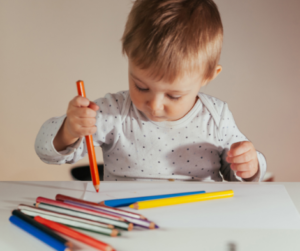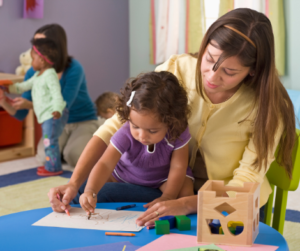Is your child ready to learn to write letters? This is a question that not enough daycares, preschools, and kindergarten classes are asking. Instead, they are jumping into teaching letter writing to younger and younger kids. But the truth is, there is a developmental path to writing. When we start teaching writing to children so young, we ignore their natural, developmentally appropriate path. This often causes them to develop bad habits and poor handwriting.
Starting on the journey
 At around 18 months old most toddlers discover crayons. They grip them in a fist—also called a fisted grasp—and scribble with big motions that involve moving the whole arm. Parents are often thrilled until they discover their child has scribbled on everything they own. Children this age scribble for the pure joy of making marks on things. They are not concerned about the finished product of their “art.”
At around 18 months old most toddlers discover crayons. They grip them in a fist—also called a fisted grasp—and scribble with big motions that involve moving the whole arm. Parents are often thrilled until they discover their child has scribbled on everything they own. Children this age scribble for the pure joy of making marks on things. They are not concerned about the finished product of their “art.”
There are actually better ways to encourage them to develop fine motor control than giving them crayons, which they aren’t ready to use. Almost all age-appropriate toys that a child can interact with at this age will help develop motor control that they need. A spoon is a more important thing to learn to grasp and manipulate than a crayon for children this age.
Building Control
Around age 2-2 ½ children start to experiment more with how to hold the crayon. They work on a palmar grasp—putting their fingers on the crayon, but keeping their wrist up and making slightly more controlled strokes. They may be able to imitate making a line and scribbling in circles.
Children this age need to continue to build their finger control and hand strength. Activities like playing with small cars and blocks are good for this. And activities like finger painting help them learn to use just one finger at a time, which prepares them for a more mature grasp.
 At ages 3 to 4, children develop a five-fingered grasp. In this grasp, the child puts their thumb and all their fingertips on the crayon or pencil. Having so many fingertips on the crayon gives the child more control of the crayon. At this stage, the child may be able to imitate making more controlled vertical and horizontal lines and may be able to draw a circle. They may make art with intention and attempt to draw simple people and objects when encouraged.
At ages 3 to 4, children develop a five-fingered grasp. In this grasp, the child puts their thumb and all their fingertips on the crayon or pencil. Having so many fingertips on the crayon gives the child more control of the crayon. At this stage, the child may be able to imitate making more controlled vertical and horizontal lines and may be able to draw a circle. They may make art with intention and attempt to draw simple people and objects when encouraged.
If you introduce handwriting at this stage, the child may become fixed on this grasp pattern and not be able to transition to the more mature tripod grasp. To help them develop a more mature grip, encourage them to paint, especially on upright surfaces like an easel.
Developing a Mature Grasp
 Around age 5-6, children are ready to develop a mature grasp that they will use for writing. Generally, we encourage them to use a tripod grasp, placing the thumb and first 2 fingers on the pencil. The ring and pinky fingers curl in and rest on the paper with the wrist. There are other mature gasps, but the tripod is the one most often taught. Giving children very short crayons, chalk or rock crayons that are not big enough to place all 4 fingers on can be used to encourage this mature grasp pattern and strengthen the fingers.
Around age 5-6, children are ready to develop a mature grasp that they will use for writing. Generally, we encourage them to use a tripod grasp, placing the thumb and first 2 fingers on the pencil. The ring and pinky fingers curl in and rest on the paper with the wrist. There are other mature gasps, but the tripod is the one most often taught. Giving children very short crayons, chalk or rock crayons that are not big enough to place all 4 fingers on can be used to encourage this mature grasp pattern and strengthen the fingers.
This child is able to copy drawing a triangle and a square when shown how and can repeat that skill. They should be able to color with control, cut with scissors, and draw pictures of things that are recognizable instead of the scribbles of earlier stages. The child who can do all of these things is usually ready to start to learn to write letters and numbers.
Patience and Practice
It is important to realize that these skills may start to emerge at age 5, but many children don’t have them until age 6 or 7. Despite this, schools push children to write in grammatically correct sentences at 5, when they should instead be teaching handwriting in a very slow and steady way. If we teach handwriting when children are ready and don’t rush them, they can develop good handwriting habits they will have for the rest of their lives.
 Children continue to develop fine motor control, grasp, and the skills needed for good handwriting for several more years. This is why schools used to wait to teach cursive writing until children were 8, 9, or 10 years old. By that age, the child has developed the hand-eye coordination needed for learning this more mature form of writing. Learning cursive also marked a step towards asking the child to write longer sentences and passages that they were not asked to do before.
Children continue to develop fine motor control, grasp, and the skills needed for good handwriting for several more years. This is why schools used to wait to teach cursive writing until children were 8, 9, or 10 years old. By that age, the child has developed the hand-eye coordination needed for learning this more mature form of writing. Learning cursive also marked a step towards asking the child to write longer sentences and passages that they were not asked to do before.
In prior generations, “penmanship” was taught up until high school as students practiced their handwriting and kept improving it. This is why your grandmother has beautiful handwriting. It was a skill that she was not only taught but encouraged to practice.
Trusting The Process
Some children move through these stages more quickly and some more slowly. The age ranges above are rather long because these skills emerge differently in each child. If you are homeschooling and can set your own pace for teaching writing, it is important to allow your child’s development to come first and to teach writing when they are ready.
 Many children also benefit from being taught to write slowly. Teaching each letter, one by one, so that children develop good handwriting habits is time well invested. All too often, children are instructed to start writing before they understand how to form letters. This leads to drawing the letters instead of writing them while using a strange grasp.
Many children also benefit from being taught to write slowly. Teaching each letter, one by one, so that children develop good handwriting habits is time well invested. All too often, children are instructed to start writing before they understand how to form letters. This leads to drawing the letters instead of writing them while using a strange grasp.
Children with developmental delays generally go through these stages much more slowly. They do still progress through the stages, given time and encouragement. Writing for them may take place much later. But if we keep in mind the stages they need to go through, they can get there too. Giving them plenty of opportunities to develop their grasp and hand strength will help them to eventually be able to write as well as their peers.
It is my dream that someday we have schools and daycares that follow child development. Schools that help our kids go through these stages appropriately. Instead of asking 3 and 4-year-olds to write, my hope is that they help children develop good gross and fine motor control—with activities like painting and using play dough—and leave the writing for when they are older.





0 Comments